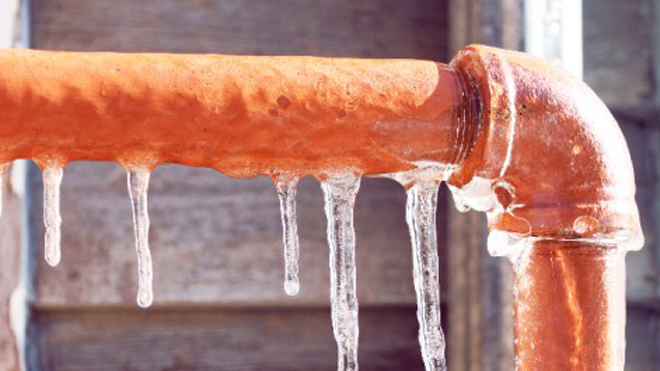Key Methods for Avoiding Frozen Pipes in Cold Weather
Key Methods for Avoiding Frozen Pipes in Cold Weather
Blog Article
Just how do you actually feel on the subject of Helpful Tips to Prevent Frozen Pipes this Winter?

Winter can wreak havoc on your pipes, especially by freezing pipes. Right here's how to avoid it from occurring and what to do if it does.
Introduction
As temperature levels decline, the danger of frozen pipelines rises, possibly leading to pricey repair work and water damage. Comprehending just how to stop icy pipelines is critical for home owners in chilly climates.
Avoidance Tips
Protecting prone pipelines
Cover pipelines in insulation sleeves or utilize warmth tape to shield them from freezing temperature levels. Concentrate on pipes in unheated or outside areas of the home.
Home heating strategies
Maintain interior areas effectively heated up, particularly locations with pipes. Open cupboard doors to enable warm air to circulate around pipes under sinks.
Exactly how to determine frozen pipes
Try to find lowered water flow from faucets, uncommon odors or sounds from pipes, and noticeable frost on subjected pipelines.
Long-Term Solutions
Architectural modifications
Think about rerouting pipelines far from outside wall surfaces or unheated locations. Add additional insulation to attics, basements, and crawl spaces.
Updating insulation
Buy high-quality insulation for pipelines, attic rooms, and walls. Proper insulation aids preserve consistent temperature levels and minimizes the risk of icy pipes.
Protecting Outside Plumbing
Yard hose pipes and exterior faucets
Separate and drain yard hoses prior to winter. Set up frost-proof faucets or cover outdoor faucets with shielded caps.
Comprehending Icy Pipelines
What causes pipes to ice up?
Pipelines ice up when revealed to temperature levels below 32 ° F (0 ° C) for extended periods. As water inside the pipelines freezes, it increases, taxing the pipeline walls and potentially triggering them to rupture.
Risks and damages
Frozen pipelines can bring about water supply disruptions, residential or commercial property damages, and pricey repair services. Burst pipelines can flooding homes and create considerable structural damages.
Indications of Frozen Pipes
Determining icy pipes early can stop them from bursting.
What to Do If Your Pipes Freeze
Immediate activities to take
If you suspect frozen pipelines, keep faucets open up to soothe pressure as the ice melts. Make use of a hairdryer or towels soaked in hot water to thaw pipelines gradually.
Conclusion
Protecting against frozen pipes needs aggressive measures and quick actions. By recognizing the reasons, signs, and preventive measures, house owners can shield their pipes throughout winter.
5 Ways to Prevent Frozen Pipes
Drain Outdoor Faucets and Disconnect Hoses
First, close the shut-off valve that controls the flow of water in the pipe to your outdoor faucet. Then, head outside to disconnect and drain your hose and open the outdoor faucet to allow the water to completely drain out of the line. Turn off the faucet when done. Finally, head back to the shut-off valve and drain the remaining water inside the pipe into a bucket or container. Additionally, if you have a home irrigation system, you should consider hiring an expert to clear the system of water each year.
Insulate Pipes
One of the best and most cost-effective methods for preventing frozen water pipes is to wrap your pipes with insulation. This is especially important for areas in your home that aren’t exposed to heat, such as an attic. We suggest using foam sleeves, which can typically be found at your local hardware store.
Keep Heat Running at 65
Your pipes are located inside your walls, and the temperature there is much colder than the rest of the house. To prevent your pipes from freezing, The Insurance Information Institute suggests that you keep your home heated to at least 65 degrees, even when traveling. You may want to invest in smart devices that can keep an eye on the temperature in your home while you’re away.
Leave Water Dripping
Moving water — even a small trickle — can prevent ice from forming inside your pipes. When freezing temps are imminent, start a drip of water from all faucets that serve exposed pipes. Leaving a few faucets running will also help relieve pressure inside the pipes and help prevent a rupture if the water inside freezes.
Open Cupboard Doors
Warm your kitchen and bathroom pipes by opening cupboards and vanities. You should also leave your interior doors ajar to help warm air circulate evenly throughout your home.

Hopefully you enjoyed reading our piece on Preventing and dealing with frozen pipes. Thank you so much for taking time to read our piece of content. Liked our entry? Please quickly share it. Help other people discover it. We enjoy reading our article about How to Prevent Your Pipes From Freezing.
Schedule Report this page